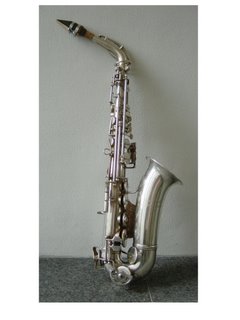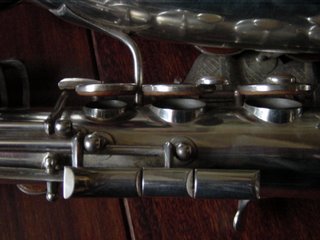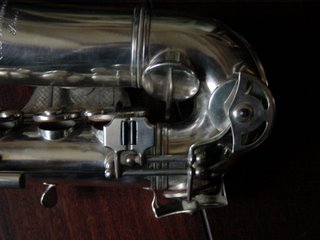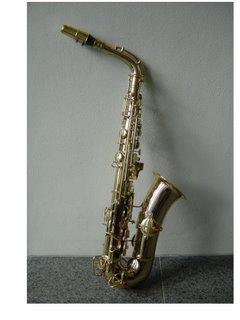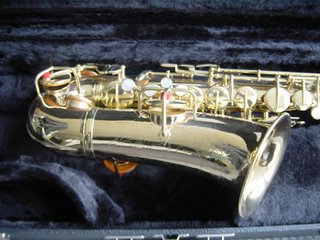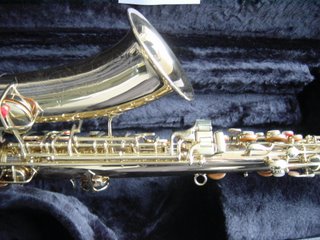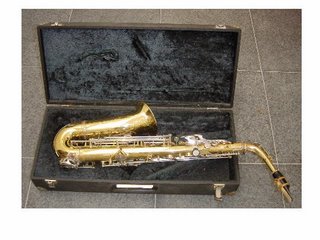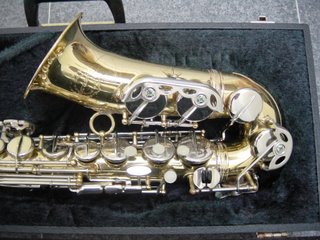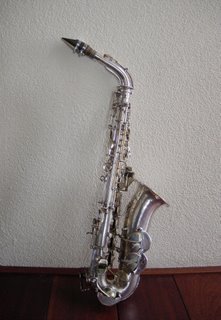GUILLARD BIZEL

This beautiful instrument has been imported
by the Lyon based musical instrument dealer Guillard Bizel.
Bizel is not a saxophone manufacturer and after some
information someone gave me this instrument proves to be
a genuine Orsi, one of the greatest woodwind factories in Italy.
Orsi is a manufacturer of about anything you can blow in!

This particular instrument has extra keys and
is modern in the way that intonation proves to be
very good as is ease of playing.

By clicking on this picture you are able to see
that the name Guillard Bizel is a later addition
after the instrument has been send to them.
In fact that part of the inscription has been done
with obvious less care!

A sturdy built instrument with a nice tone.
Knowing the Orsi models the sound is
of course quite Selmeresc.

The case can most often be used as a guide
of finding the right fabrication: In any way
Italian and a lot like the Grassi cases!
B&S ALTO SAXOPHONES

Saxophone was invented by Adolphe Sax in Belgium.
As an alive and continuously developing instrument,
it is befitting that the saxophone continues its forward growth
while retaining the refinements of the French made
Selmer MKVI's silky feel, style, modern keys,
modern ergonomics and big bore tone....
With this horn, the German craftsman have taken it to a new level!

Indeed a lot of features on this mid seventies produced german
saxophone reminds of the Selmer Mark VI.
While in the beginning B&S only built one model
that had a professional level, they later developed
several models, also intermediate saxes among others.

As I can have had my hands on different B&S saxophones
I must say this instrument, being one of the earlier ones, has
a nice feel and a really smooth tone.

Let's go back to what I found on the internet with
many thanks for the author:
For those of you who havn't heard or played a B&S Sax...I reference it to a Selmer. This sax is definitely comparable feel and tone wise and can go from smoke and sultry to getting that big bore post bop Joe Henderson mean sound. It is many a players opinion that it is a better made horn than most of the Japanese made counterparts. No thin sounding metal here. Think focused centered and THICK big bore tone. Feels like a vintage horn because it is. (1970's hand crafted make)This is not to be confused with one of the recent B&S stencil models.

Look for B&S BLue Label Alto or Tenor and see what players have to say about them.
As you may know, the early blue label models are VERY rare.
B&S Blue Label circa 1975... Hand made by German craftsman.
This label can be seen on the second picture: The Bell to body construction.
DUO COLOUR B&S ALTO SAXOPHONE

These saxophones were produced in Markneukirchen (Klingenthal)
Unlike any other, the saxon region of the Vogtland looks back on over 100 years of tradition in the development and manufacturing of wind instruments. The first German saxophone was built in 1901 in Markneukirchen, and by the 1920's, they were being sold all over the world.

During the times of the old Eastern Germany (GDR), the majority of the Vogtland saxophone manufacturers were brought together to form the VEB Blechblas (Brass Blow) - und Signal - Instrumenten - Fabrik. Today, this tradition lies in the hands of Vogtlandische Musikinstrumentenfabrik GmbH, who as well as continuing the handcraft traditions, also works towards developing new and innovative ideas together with leading saxophone players and specialists from around the world, including Wolf Codera and Dave Guardala.

A picture of the engraving of this instrument that says:
B&S Markneukirchen - Klingenthal.

As for registration numbers: One of the visitors of my blog
found out that the number 9393 is said to be built in 1959.
Doubts are where it is built: In Klingenthal or Markneukirchen.
Then the instrument here above should be even older and
to be honest: I doubt that. Perhaps the cities mentioned
had their own numbering system. B & S is still in business
and you can reach them by tel:
+49 (37422) 581-32
or E-mail under:
virginia.weber@b-and-s.com
The registration of this instrument clearly states
that this is not a later far eastern import saxophone.
Silverplated "PAUL BEUSCHER" ALTO SAXOPHONE (STENCIL)
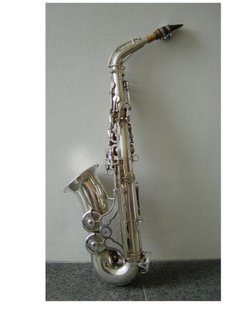
Silverplated Paul Beuscher Stencil that appears to be
a Boiste made instrument with more deluxe keyguards.
Manufacturers like Couesnon or Malerne also made instruments
for this music dealer in Paris.




















